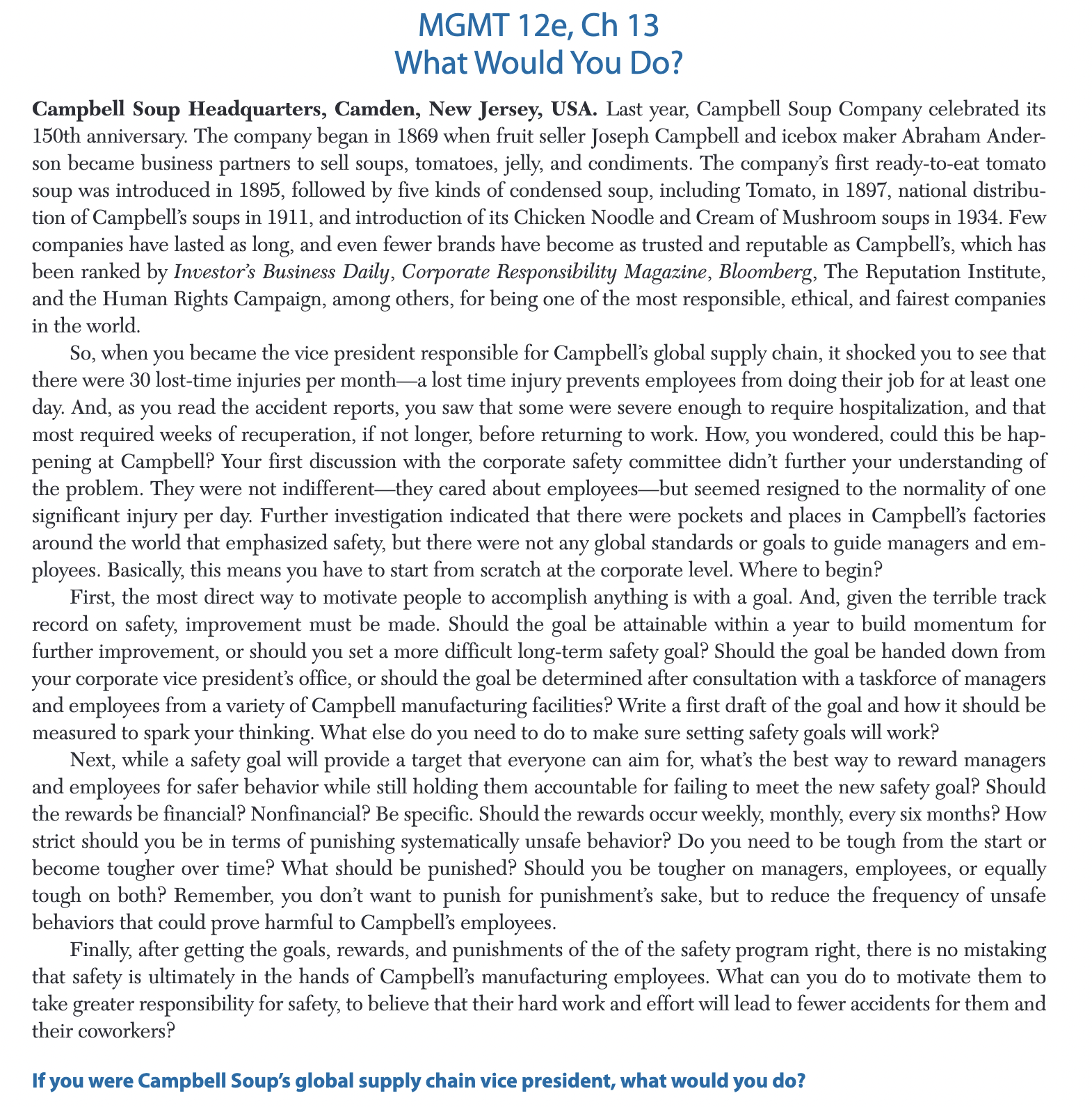Answered step by step
Verified Expert Solution
Question
1 Approved Answer
MGMT 12e, Ch 13 What Would You Do? Campbell Soup Headquarters, Camden, New Jersey, USA. Last year, Campbell Soup Company celebrated its 150th anniversary.

MGMT 12e, Ch 13 What Would You Do? Campbell Soup Headquarters, Camden, New Jersey, USA. Last year, Campbell Soup Company celebrated its 150th anniversary. The company began in 1869 when fruit seller Joseph Campbell and icebox maker Abraham Ander- son became business partners to sell soups, tomatoes, jelly, and condiments. The company's first ready-to-eat tomato soup was introduced in 1895, followed by five kinds of condensed soup, including Tomato, in 1897, national distribu- tion of Campbell's soups in 1911, and introduction of its Chicken Noodle and Cream of Mushroom soups in 1934. Few companies have lasted as long, and even fewer brands have become as trusted and reputable as Campbell's, which has been ranked by Investor's Business Daily, Corporate Responsibility Magazine, Bloomberg, The Reputation Institute, and the Human Rights Campaign, among others, for being one of the most responsible, ethical, and fairest companies in the world. So, when you became the vice president responsible for Campbell's global supply chain, it shocked you to see that there were 30 lost-time injuries per month-a lost time injury prevents employees from doing their job for at least one day. And, as you read the accident reports, you saw that some were severe enough to require hospitalization, and that most required weeks of recuperation, if not longer, before returning to work. How, you wondered, could this be hap- pening at Campbell? Your first discussion with the corporate safety committee didn't further your understanding of the problem. They were not indifferentthey cared about employees-but seemed resigned to the normality of one significant injury per day. Further investigation indicated that there were pockets and places in Campbell's factories around the world that emphasized safety, but there were not any global standards or goals to guide managers and em- ployees. Basically, this means you have to start from scratch at the corporate level. Where to begin? First, the most direct way to motivate people to accomplish anything is with a goal. And, given the terrible track record on safety, improvement must be made. Should the goal be attainable within a year to build momentum for further improvement, or should you set a more difficult long-term safety goal? Should the goal be handed down from your corporate vice president's office, or should the goal be determined after consultation with a taskforce of managers and employees from a variety of Campbell manufacturing facilities? Write a first draft of the goal and how it should be measured to spark your thinking. What else do you need to do to make sure setting safety goals will work? Next, while a safety goal will provide a target that everyone can aim for, what's the best way to reward managers and employees for safer behavior while still holding them accountable for failing to meet the new safety goal? Should the rewards be financial? Nonfinancial? Be specific. Should the rewards occur weekly, monthly, every six months? How strict should you be in terms of punishing systematically unsafe behavior? Do you need to be tough from the start or become tougher over time? What should be punished? Should you be tougher on managers, employees, or equally tough on both? Remember, you don't want to punish for punishment's sake, but to reduce the frequency of unsafe behaviors that could prove harmful to Campbell's employees. Finally, after getting the goals, rewards, and punishments of the of the safety program right, there is no mistaking that safety is ultimately in the hands of Campbell's manufacturing employees. What can you do to motivate them to take greater responsibility for safety, to believe that their hard work and effort will lead to fewer accidents for them and their coworkers? If you were Campbell Soup's global supply chain vice president, what would you do?
Step by Step Solution
There are 3 Steps involved in it
Step: 1

Get Instant Access to Expert-Tailored Solutions
See step-by-step solutions with expert insights and AI powered tools for academic success
Step: 2

Step: 3

Ace Your Homework with AI
Get the answers you need in no time with our AI-driven, step-by-step assistance
Get Started


